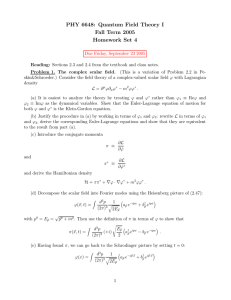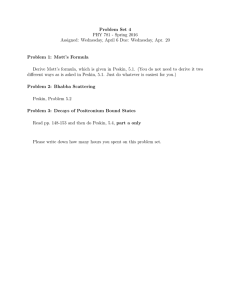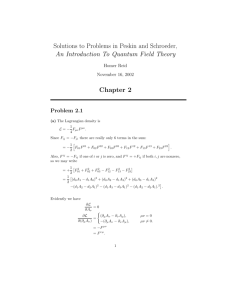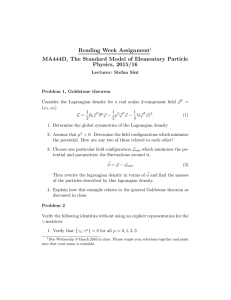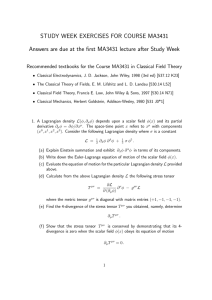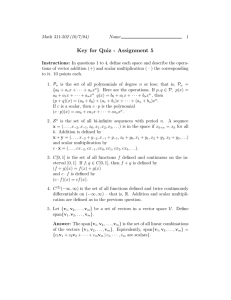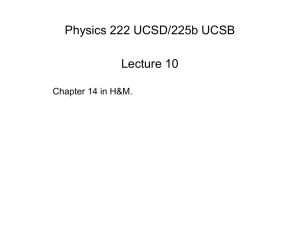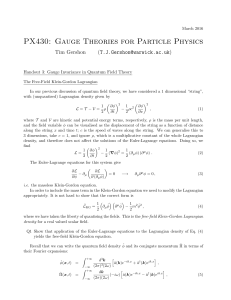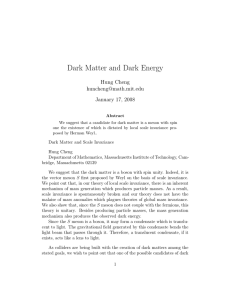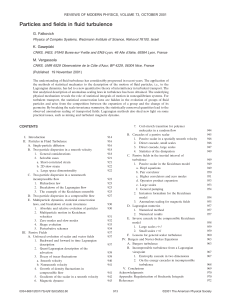PHY 6648: Quantum Field Theory I Fall Term 2015 Homework Set 3
advertisement
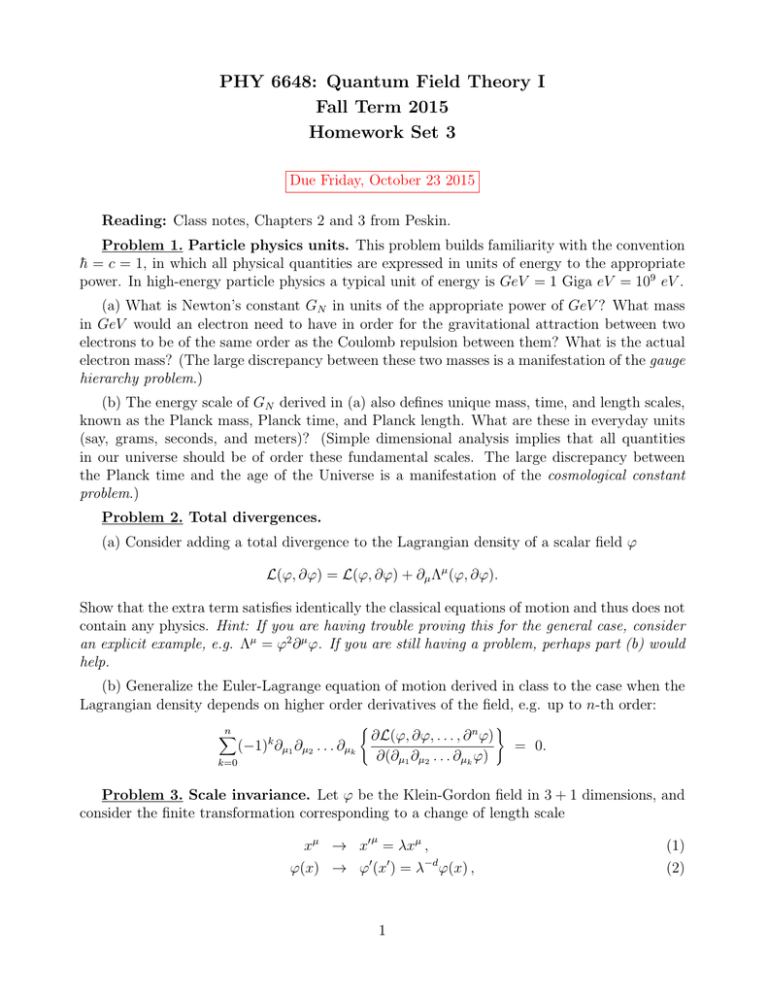
PHY 6648: Quantum Field Theory I Fall Term 2015 Homework Set 3 Due Friday, October 23 2015 Reading: Class notes, Chapters 2 and 3 from Peskin. Problem 1. Particle physics units. This problem builds familiarity with the convention h̄ = c = 1, in which all physical quantities are expressed in units of energy to the appropriate power. In high-energy particle physics a typical unit of energy is GeV = 1 Giga eV = 109 eV . (a) What is Newton’s constant GN in units of the appropriate power of GeV ? What mass in GeV would an electron need to have in order for the gravitational attraction between two electrons to be of the same order as the Coulomb repulsion between them? What is the actual electron mass? (The large discrepancy between these two masses is a manifestation of the gauge hierarchy problem.) (b) The energy scale of GN derived in (a) also defines unique mass, time, and length scales, known as the Planck mass, Planck time, and Planck length. What are these in everyday units (say, grams, seconds, and meters)? (Simple dimensional analysis implies that all quantities in our universe should be of order these fundamental scales. The large discrepancy between the Planck time and the age of the Universe is a manifestation of the cosmological constant problem.) Problem 2. Total divergences. (a) Consider adding a total divergence to the Lagrangian density of a scalar field ϕ L(ϕ, ∂ϕ) = L(ϕ, ∂ϕ) + ∂µ Λµ (ϕ, ∂ϕ). Show that the extra term satisfies identically the classical equations of motion and thus does not contain any physics. Hint: If you are having trouble proving this for the general case, consider an explicit example, e.g. Λµ = ϕ2 ∂ µ ϕ. If you are still having a problem, perhaps part (b) would help. (b) Generalize the Euler-Lagrange equation of motion derived in class to the case when the Lagrangian density depends on higher order derivatives of the field, e.g. up to n-th order: n X ( k (−1) ∂µ1 ∂µ2 . . . ∂µk k=0 ∂L(ϕ, ∂ϕ, . . . , ∂ n ϕ) ∂(∂µ1 ∂µ2 . . . ∂µk ϕ) ) = 0. Problem 3. Scale invariance. Let ϕ be the Klein-Gordon field in 3 + 1 dimensions, and consider the finite transformation corresponding to a change of length scale µ xµ → x0 = λxµ , ϕ(x) → ϕ0 (x0 ) = λ−d ϕ(x) , 1 (1) (2) where d is the dimension of the field and λ is the parameter of the transformation. (a) Use Noether’s theorem to construct the current J µ associated with this transformation. (b) Consider the following Lagrangian density for the scalar field ϕ(x) 1 1 1 L = ∂ µ ϕ∂µ ϕ − m2 ϕ2 − gϕ4 . 2 2 4! What is the value of d? Hint: Use dimensional analysis. (c) For what values of m and g will J µ be conserved? Check that in that case the transformation (1-2) is indeed a symmetry of the Lagrangian. Problem 4. Classical electromagnetism. Problem 2.1 in Peskin&Schroeder, supplemented with the following: (c) Show that the extra term ∂λ K λµν which was added to the energy-momentum tensor in part (b), does not affect the conserved quantities (total energy and momentum), as long as K λµν is antisymmetric in it first two indices (λµ). (d) In part (a) you will only find two of Maxwell’s equations. Show that εµνρσ ∂ ν F ρσ = 0 is an identity which provides the two missing equations. Problem 5. The complex scalar field. (This is a variation of Problem 2.2 in Peskin&Schroeder.) Consider the field theory of a complex-valued scalar field ϕ with Lagrangian density L = ∂ µ ϕ∂µ ϕ∗ − m2 ϕϕ∗ . (a) It is easiest to analyze the theory by treating ϕ and ϕ∗ rather than ϕ1 ≡ Reϕ and ϕ2 ≡ Imϕ as the dynamical variables. Show that the Euler-Lagrange equation of motion for both ϕ and ϕ∗ is the Klein-Gordon equation. (b) Justify the procedure in (a) by working in terms of ϕ1 and ϕ2 : rewrite L in terms of ϕ1 and ϕ2 , derive the corresponding Euler-Lagrange equations and show that they are equivalent to the result from part (a). (c) Introduce the conjugate momenta π ≡ ∂L ∂ ϕ̇ π∗ ≡ ∂L ∂ ϕ̇∗ and and derive the Hamiltonian density H = ππ ∗ + ∇ϕ · ∇ϕ∗ + m2 ϕϕ∗ . 2 (d) Decompose the scalar field into Fourier modes using the Heisenberg picture of (2.47): ϕ(~x, t) = with p0 = Ep~ = √ d3 p 1 † ipx −ipx q e a e + b p ~ p ~ (2π)3 2Ep~ Z p~2 + m2 . Then use the definition of π in terms of ϕ to show that π(~x, t) = d3 p (+i) (2π)3 Z s Ep~ † ipx ap~ e − bp~ e−ipx . 2 (e) Having found π, we can go back to the Schrodinger picture by setting t = 0: ϕ(x) = π(x) = Z Z d3 p 1 † i~ p·~ x −i~ p·~ x q e a e + b p ~ p ~ (2π)3 2Ep~ d3 p (+i) (2π)3 s Ep~ † i~p·~x ap~ e − bp~ e−i~p·~x . 2 Quantize the field by imposing the usual commutation relations h [ϕ(~x), π(~y )] = iδ (3) (~x − ~y ), h i ϕ† (~x), π † (~y ) = iδ (3) (~x − ~y ), i i h [ϕ(~x), ϕ(~y )] = ϕ† (~x), ϕ† (~y ) = [π(~x), π(~y )] = π † (~x), π † (~y ) = 0, h i h i h i h i ϕ(~x), ϕ† (~y ) = ϕ(~x), π † (~y ) = π(~x), ϕ† (~y ) = π(~x), π † (~y ) = 0 . Pick one of these relations and show that it is satisfied provided that h i h ap~ , a†q~ = (2π)3 δ (3) (~p − ~q), i bp~ , b†q~ = (2π)3 δ (3) (~p − ~q) and all other commutators involving a’s and/or b’s vanish. (f) Derive the Hamiltonian operator H= Z d3 p † † E a a + b b . p ~ p ~ p ~ p ~ p ~ (2π)3 (g) [Extra credit] At this point, the a and b particles look indistinguishable. Recall that there is a conserved charge in this theory due to invariance under phase rotations (see Eq. (2.15)). Derive the conserved charge in the classical theory and show that in the quantized theory it is given by the relative number of a and b particles: Q=± Z d3 p † † a a − b b . p ~ p ~ p ~ p ~ (2π)3 If we identify this with the electric charge, this implies that a† and b† create states of the same mass m, but opposite charge, i.e. particles and antiparticles. What determines the overall sign of Q? 3

